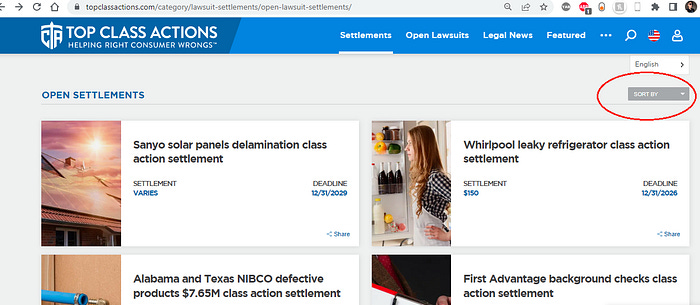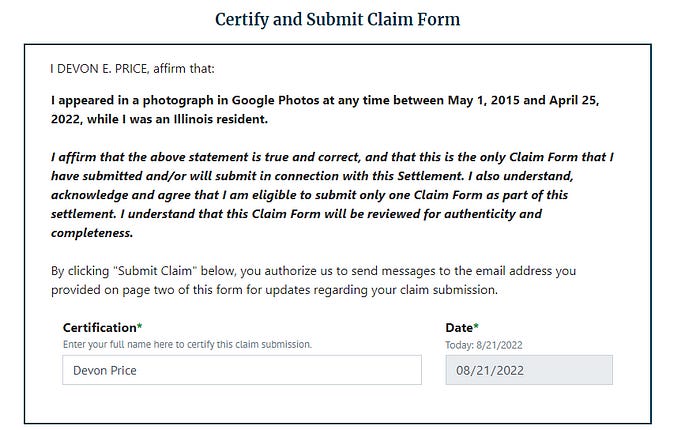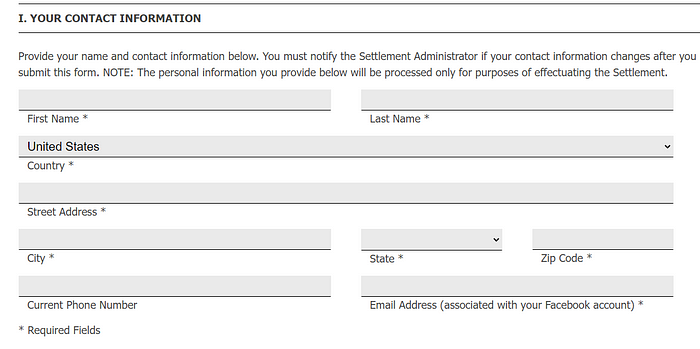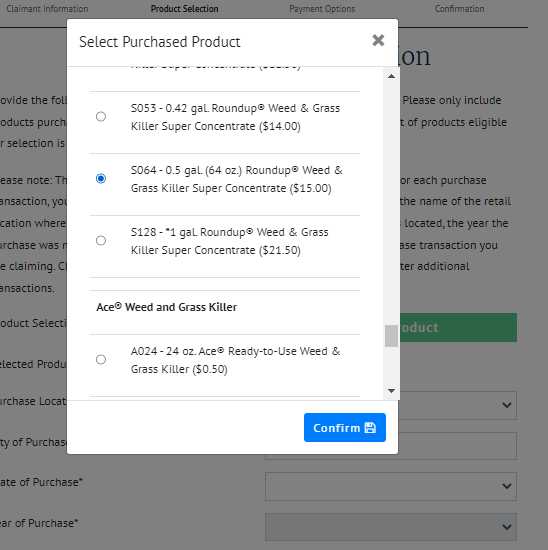Swindling Corporations for Fun and Profit
I’ve made thousands of dollars by filling out class action settlement forms online. Here’s how you can, too.
This essay was originally published to Medium on September 1, 2022.
In the mid-2010s, I’d check blogs like Consumerist regularly. I’d sit down with my coffee and cereal in the morning, pop open the site, and read about the latest product the grocery store shrink ray had secretly reduced in size overnight (a phenomenon we all refer to as shrinkflation now), or review a handy list of all the food and drink products the TSA permits to pass through the security line, if flyers want to save money on overpriced airport food.
I was a graduate student living in Chicago on a lean $14,000-a-year stipend. My $800 rent absorbed over half that money right out. So I read a lot about personal finance, and was forever on the lookout for tips and tricks that would cut my expenses and supplement my income.
I was a teaching assistant at my university, so I ordered textbook samples from all the big publishers each semester, then trotted over to the bookstore to resell them for cash. I wandered over to on-campus events for prospective students and their parents and wolfed down the free food. I lived near campus so I could steal the wi-fi. I pirated a lot of media off that free internet (and got caught, and had to pay a $50 fine to the Recording Industry Association of America for downloading an mp3 of Rihanna’s song S&M). And I spent a lot of time on Consumerist, Lifehacker, and Mr Money Mustache.
(Remember when we used to sit down every day to intentionally check specific websites, rather than scrolling passively through our social media feeds? I’ve been thinking a lot lately about how much I miss those days of intentionally parceled out internet usage. I’d like to get back to them. That might be a subject of a future piece, once I sort it out in my own life.)
It was on blogs like those that I discovered a site that I still regularly check today, because it continues to come through for me, regularly boosting my bank account while also granting me peace of mind: TopClassActions.com.
Top Class Actions dot com aggregates the latest news about which corporations are currently getting sued by consumers and former employees, which recent lawsuits have been won, and which groups of consumers & workers (or “classes”) are now eligible for a payout from a suit. The site is a great place to track the many ways in which corporations are routinely screwing us over: falsely advertising products to us as heart-healthy or sulfate-free, selling our phone numbers to telemarketers without our consent, mining our social media data and tracking our browsing activity, renewing our subscriptions with added fees, storing our fingerprint biodata without our knowledge, and on and on and on.
Crucially, Top Class Actions is also a site where users can sign up to join class action lawsuit claims and get a personal payout. And that’s why I keep coming back to it with such consistency. Top Class Actions is one of the rare places where learning about the latest act of corporate malfeasance comes with a silver lining: it may be upsetting to learn that Facebook collected facial recognition data from me without my knowledge, but at least I’m getting $397 for the revelation.

I have been using TopClassActions.com to find and apply for class action settlements for many years, and in that time I’ve made literally thousands of dollars from just casually browsing through the claims and filling out forms.
Each year, dozens of American corporations get sued by large consumer classes for a variety of misleading, unethical, and illegal acts, and when those corporations lose, anywhere from a few hundred thousand to millions of dollars gets put on the table for everyday people to claim. Applying to receive money from these settlements only takes a few minutes and a couple of clicks most of the time, and in some cases, doing so doesn’t even require providing proof that you’ve purchased an eligible product or service in the past.
Once you learn how to use the site to your advantage, and know what to expect from the process, it becomes a simple, satisfying income supplement. I spend about two hours on the Top Class Actions site every month or two, reviewing new suits and filling out forms. Then I just wait for the checks to roll in (or for the payments to hit my PayPal or Venmo accounts, which are among the payout options on many settlements now).

Sometimes the earnings are meager: $8 for Burt’s Bees lip balm that was contaminated with forever chemicals, $16.19 for seafood that wasn’t sustainably sourced, $14 for dog food that wasn’t really “grain free.” Other times, though, the settlement payouts are substantial. I once made $200 from an airline that had been adding unadvertised fees to their ticket prices, and $1400 from a tech manufacturer whose disk drives were faulty. I didn’t need to submit proof of purchase for any of these! I just generously estimated how much money I’d spent on lip balms, airline tickets, and laptops with disk drives during the time period covered by the lawsuit.
Navigating the Top Class Actions site to find and apply for claims takes a little practice and strategic thinking to get the hang of, but that’s why I’m writing this piece. I’ve posted online about my love of the website quite a few times, and given podcast interviews about it, but many people find the settlement application process intimidating, or understandably believe that signing up online for free money sounds far too good to be true. But it actually isn’t! All you need is a few hours every couple of months and you can get yourself set up for a slow but easy stream of spending money.
So here it is, my detailed guide on how to make money effectively from Top Class Actions — along with some caveats, to help keep people’s expectations realistic and their odds of getting penalized for perjury as low as possible.
Finding Open Settlements
The first thing you want to do is head on over to topclassactions.com, hover over the “Settlements” tab on top bar, and then click on the first item in the drop-down menu, “Open Settlements.”
Next you’ll want to scroll down a bit, eyeballing the Featured Settlements section to see if any of the settled suits that are making the news right now apply to you.
Hey look! Facebook lost a class action suit again — this time for collecting users’ browsing activity without their knowledge. If you are a Facebook user in the United States and you had an account during 2010 or 2011, you are eligible for money from Meta via this lawsuit.
It turns out that any time you used a website that had a Facebook-based comment section, Facebook was collecting data on you without your knowledge. This particular form is super easy to fill out, so you can take a stab at it on your own right now —or you can open it in a new tab and leave it waiting for now, and we’ll discuss how to complete it later in this piece.
Scroll down past the “Featured Settlements” and you will see a section listing all “Open Settlements.” Notice the “Sort By” button in the upper right, which here I’ve circled in red:
Click that button and select “Deadline” to sort by deadline.
This will bring up the settlements applications that are closing the soonest, which is the best place to start if you are a first-time Top Class Actions user. After all, you don’t want to miss out on settlements you qualify for that are rapidly running out. This will return pages upon pages, detailing dozens of active settlements. Here’s how you pick through them to find the ones worth applying for:
Sift Through the Settlements
As you scroll through the numerous open settlements on offer, you want to look for ones with a couple of attributes: suits that deal with a consumer product or widely available service, offering a payment of less than $5,000, and requiring no proof of purchase. These are the types of settlements that will be the easiest for the average person to apply for. If you see settlements related to commonly-purchased groceries and household items, for example, you’ll almost certainly want to click them.
Along the way, you’ll also see settlements that are far more specific: suits for hourly Shake Shack employees in New York, for instance, or for holders of Capital One bank accounts. There’s even a settlement available to the indigenous survivors of Canadian residential schools. If you fall into any of these categories, you’ll want to click on those suits as well of course; they tend to pay out a great deal, but require extensive documentation and proof of eligibility.
Looking through this list of open settlements with September deadlines, for instance, two immediately jump out: the Claire’s data breach settlement and the Google Photos face recognition privacy settlement. Millions of people have shopped at Claire’s and most people reading this probably have a Google Photos account, so the odds are good that applying to these suits will require minimal proof for a decent payout.
Looking through this list of settlements above, the Nexium price fixing and the Roundup weed killer false advertising cases are also safe bets. Pharmaceutical settlements tend to pay off very well, but don’t usually require you to upload proof of purchase or a doctor’s prescription. And we can see that the Roundup case pays between fifty cents and thirty-three dollars for each item you claim to have bought, which is a pretty good sign that purchase receipts are not required — just a count of how many units of weed killer you think you have bought.
Open any & all promising-seeming settlements in a new tab and save them for the next step in the process.
Review Settlement Requirements
Now that you’ve clicked through the site a bit and opened up a bunch of settlements in new tabs, it’s time to review their specifics. Each settlement page contains a ton of background information on the legal case, most of which you can completely ignore and scroll past, unless you happen to be curious:
Here, for example, are the details on the Google Photos case. It’s an interesting one that likely touches your actual life, so it’s worth reading. The tech giant has been scanning through users’ photos and collecting biometric “faceprint” data without consent for years, leaving anyone with a Google Photo account at risk of fraud, data privacy leaks, and having our identifying information turned over to the police during active investigations, without our ever knowing it. Yeah, this is a settlement you’ll want to get your coins for.
Scroll down a bit until you get to the section listing eligibility, payment amount info, and proof of purchase requirements.
Based on the eligibility requirements, anyone who lives in Illinois and appeared in any photo stored on Google Photos between May 1, 2015 and April 25, 2022 can apply for this settlement payment. You do not need to prove that there are photos of you on Google Photos in order to qualify for money here. You don’t even have to prove you are actually an Illinois resident. All you have to do is provide your name, current address, and information on how you’d like to receive your payment, and then check a box certifying that you do meet the requirements.
And look, you can get paid via PayPal, Venmo, a prepaid Mastercard, or Zelle! So even if the Illinois address you provide is not current or contains mistakes, or you live elsewhere, you can still get paid from this suit:
Let’s take a look at another one of the suits we saved, involving a data breach at Claires:
It looks like the eligibility criteria for this suit are more rigidly enforced: you have to provide the last four digits of the credit card that was involved in the data breach. The payment for consumers who do qualify is quite handsome, at three thousand dollars, but I didn’t use a credit card at Claire’s during the spring or summer of 2020, so it looks like I won’t be able to apply for this one.
Moving on to the Roundup weed killer suit:
This settlement pays up to $33 per bottle of weed killer that you claim to have bought, and unless you claim to have bought one of the company’s largest and most expensive weed killer products, you don’t have to provide proof of purchase. So I will definitely be filling this one out — and claiming the highest-priced bottles I can get away with without having to submit proof.
As you go through all of the settlements you have saved, identify what the specific requirements are, including time periods and areas of residence — but paying special attention to whether proof of purchase is needed. If proof is not necessary, you can always just make your best guess. There is no way for any of those companies to investigate your claims, so you can feel comfortable erring on the side of enriching yourself at their expense.
Now let’s fill out some forms!
Fill Out Settlement Forms
Remember that Facebook settlement I told you to save for later? Here’s what it’s eligibility requirements look like:
All you need to do to file for this settlement is provide either the email associated with your Facebook account, or the URL that your Facebook profile is (or was) located at. This is a really easy settlement to apply for, and if it’s anything like the Illinois-based case I talked about earlier, it might pay off as much as $400. So hit that big blue “Click Here to File a Claim” button:
This will take you to the site fbinternettrackingsettlement.com, which sounds fake, but is a secure site and absolutely real. Every time a major corporation loses a lawsuit like this, the winning class’ legal team creates a website with a suspiciously straightforward URL, in hopes that it will be easy to find and apply thru. Unfortunately, in today’s scam-ridden, social-media dominated internet, people are wary of random websites with very literal url. But if a settlement site is linked to on the Top Class Actions site, it has been vetted and is legit.
Here’s what the Facebook settlement site looks like. Hit the “Submit a Claim” button, then the “Click here” button on the right to complete a Claim Form.
Fill out your contact information:
Confirm that you did have a Facebook account in 2010 or 2011, and provide your Facebook profile URL:

Select your preferred payment method (I went with PayPal), provide a digital signature, and then hit submit:
That’s it! Clocking in at just about two or three minutes to complete, this could wind up being the easiest $400 you’ve ever made. We’re not quite sure of the exact payout amount on this case (that will depend on how many people apply and snap up a piece of the pie), but either way you’ve gotten some recompense for Facebook leeching off you.
Let’s click to file a claim on the Roundup weed killer settlement now:
This settlement site asks for your current address, and asks if this is where you bought the Roundup products you are claiming. I’m going to say yes. Next the site asks you which specific products you purchased:
Click on the green “select product” button to view a list of Roundup products. Remember, proof of purchase is not necessary to file a claim, unless you say you have bought one of the three most expensive Roundup items. I think I remember buying Roundup Weed & Grass Killer Super Concentrate, for which I will receive $15 in compensation per bottle, without having to submit proof of purchase.
And I don’t have any receipts saved, but I think I bought this weed killer concentrate at Home Depot in Chicago in 2018, and that I picked up five bottles. At fifteen dollars per bottle, that means I’m eligible to receive $75 from this settlement — all without providing any proof these purchases occurred. I might have bought more Roundup than that, but this is the most I can claim without submitting receipts, so that’s good enough for me.
Now I just check a box certifying that this information is true to the best of my knowledge, sign my name, and hit submit. Again, easy! I’ve just earned $75 from a company that actively deceived the public about the fact their products contained potentially cancer-causing ingredients. It’s a terrifying reality, but milking these corporations for all they’re worth feels good.
Now You Wait!
It can take anywhere from six months to two or three years for a settlement payment to arrive once you’ve applied for it. This is part of what makes applying for class action settlements less than too good to be true. It’s free money, sure, but it requires some tedious form-filling effort, followed by a lot of waiting for legal proceedings and bureaucratic red tape to be cut through.
You don’t always know what your payout amount is going to be, or when you’ll get it — and every now and then an application will be rejected for a variety of reasons beyond your control. Because of this, it’s best to think of using Top Class Actions as sowing seeds that you’ll one day have the opportunity to harvest, not a guarantee of a speedy return.
Just fill out the forms, opt for digital payments via PayPal/Zelle/Venmo when you can (those are disbursed faster), and if you move, make sure to set up a forwarding address, so that any settlement checks that get put in the mail find their way to you. Sometimes I receive settlement payments I signed up for three years and two apartments ago.
Fill Out Forms Regularly
I like to put on a movie or a long YouTube video essay and spend an hour or two plodding through as many settlement forms as I can manage in a sitting. Completing settlement applications is far faster and more efficient if you use a web browser that saves your address & contact information for you and uses it to auto-fill forms, such as Google Chrome. Of course, one day Google Chrome will no doubt be sued for selling users’ saved information to other companies or passing it along to the cops…so use your judgement here.
I was already a cynical, capitalism-hating scammer long before TopClassActions.com found me, but reading about all these lawsuits over the years has only made me more jaded, and more willing to grab up every last buck I can reasonably get my hands on. The first few times you use Top Class Actions dot com, you’ll be overwhelmed by all the information, carefully parsing application requirements to make sure the details you list are accurate or fitting. But as time goes on, and you get into a groove, you’ll find yourself racking up checks for canned tuna, aluminum siding, telemarketer calls, nutritional supplements, and streaming platforms with wild abandon.
It’s a fun little diversion every once in a while, and having a payment hit your account is a lovely little thrill with a dose of consumer schadenfreude. Corporations scam each of us on a daily basis, so it’s nice to be able to bite back. Happy hunting.



























